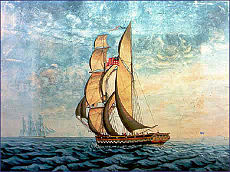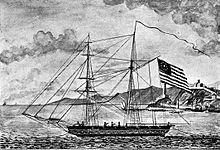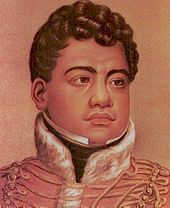- Cleopatra's Barge
-
For the cruise ship formerly known as "Pride of Hawaii", see Norwegian Jade.

1818 painting by George Ropes in Peabody Essex MuseumCareer (USA) 
Name: Cleopatra's Barge Owner: George Crowninshield Jr. Builder: Retire Becket
Salem, MassachusettsCost: $100,000 (including furnishings) Launched: October 21, 1816 Completed: December 1816 Out of service: November 1817 Career (Kingdom of Hawaii) 
Acquired: November 16, 1820 Renamed: Haʻaheo o Hawaiʻi
("Pride of Hawaii")Fate: Wrecked 1824 General characteristics Tons burthen: 192 tons bm Length: 100 ft (30.5 m) (deck)
83 ft (25 m) (water line)Beam: 23 ft (7.0 m) Draught: 11 ft (3.4 m) Propulsion: Sails Sail plan: Hermaphrodite brig Cleopatra's Barge was an opulent yacht built in Massachusetts in 1816. It became the Royal Yacht of King Kamehameha II who named it Haʻaheo o Hawaiʻi ("Pride of Hawaii"), but was wrecked in the Hawaiian Islands in 1824.
Contents
Building
In the 18th century the Crowninshield family of Salem, Massachusetts had a thriving shipping business. In the War of 1812 one of their ships became a privateer. The elder George Crowninshield (born in 1733) died in 1815 and his son inherited the business. George Crowninshield Jr. (1766–1817) ordered a pleasure craft originally called the ship Car of Concordia. At registration he renamed it Cleopatra's Barge for the pleasure barge of Egyptian Queen Cleopatra VII, based on a passage in the play Antony and Cleopatra. It was built by Retire Becket of Salem and launched October 21, 1816.[1]
The ship was 23 feet (7.0 m) wide and measured 192 tons. It had two masts in the configuration known as a hermaphrodite brig: square-rigged forward and schooner-rigged aft. This made it fast but required a relatively small crew. It cost about US$50,000 to build, and about the same amount was used on luxury furnishings. The main cabin was 19 feet (5.8 m) by 20 feet (6.1 m), with mahogany panels inlaid with other decorative wood. Furniture was covered in red velvet with gold lace, and the kitchen included custom silver, china, and formal glassware. The starboard side was painted in colorful horizontal stripes, and the port side a herring-bone pattern. It even boasted indoor plumbing.[2]:26
On December 6, 1816, the ship was opened for public tours, and it became a popular attraction for thousands of people. After a one-day trial sail, an unusually cold winter froze the ship into dock for the winter.[3] On January 14, 1817, the Salem Gazette reported:
"The elegant equipment of this vessel, by Mr. Crowninshield, for a voyage of pleasure, as it is an entire novelty in this country, has excited universal curiosity and admiration."[2]:24
Atlantic
Starting on March 30, 1817, it became the first American pure pleasure craft to sail across the Atlantic. The owner's brother Benjamin Williams Crowninshield was United States Secretary of the Navy, so provided letters of introduction from Secretary of State James Monroe and Ambassador to Great Britain John Quincy Adams. Adams' grandson John Quincy Adams II would later marry George Crowninshield Jr.'s grandniece.
An older cousin Benjamin Crowninshield (1758–1836) was master of the ship. He brought his son Benjamin Crowninshield Jr. (1782–1864) who kept a log book including sketches and watercolors recording the journey. On a six month cruise in the Mediterranean growing crowds gathered to tour the yacht at each port.[2] They reached Faial Island (which they called Fayal) in the Azores, April 24 where the American Consul gave a ball in their honor. Then they visited Funchal on the island of Madeira, Gibraltar, Málaga and other ports on the southern coast of Spain. In Marseilles the ship was repainted and redecorated. Next stops were Toulon in France and Genoa in Italy where they met astronomer Franz Xaver von Zach.[2]
It was widely suspected that the Crowninshields were planning to take former Emperor Napoléon Bonaparte from his exile on Saint Helena island back to America. They did visit several of Napoleon's supporters and relatives on the island of Elba where Napoléon had escaped in 1815. In Rome they met with Napoleon's mother Letizia Ramolino, and siblings Prince Lucien and Princess Pauline. They took on board the captain of the ship on which Napoleon escaped Elba and his doctor, along with souvenirs such as a pair of Napoléon's boots and an imperial snuffbox. They were at various times shadowed by ships from the French, British, and American Navies, as well as pirates. He would outrun them all, in informal races that predate any organized yacht racing. It was also rumored he was hoping to bring back a European Princess to marry, but he returned with neither wife nor Emperor.[2]
After arriving back in Salem from his first cruise October 3, George Crowninshield Jr. died suddenly on November 26, 1817 aboard the ship planning his next adventure. Some of the furnishings were removed and eventually ended up in the Peabody Essex Museum.[4] The Barge was auctioned off to a Crowninshield brother for US$15,400 in July 1818 and used for a few trading voyages. Boston merchants William F. Sturgis and John Bryant bought the ship in April 1820. Although Bostonians assumed it was going to be used as a trading vessel (and it was stuffed with cargo), the owners had another plan. It sailed via South America under Captain John Suter in June 1820, who had instructions to try to sell it in the Kingdom of Hawaii, then known as the "Sandwich Islands".[5]
Pacific
Just before landing the ship was cleaned up and painted. Suter had been the Hawaiian Islands on several previous trips, and as he suspected, the day after he arrived on November 6, 1820 King Kamehameha II inspected the ship and was impressed. The ancient Hawaiians had keen interest in boats, and the young king knew his father Kamehameha the Great used Western military technology such as large armed ships to conquer the islands.
On November 16, 1820 the price was negotiated as 8000 piculs of sandalwood (over a million pounds), estimated to be worth about US$80,000 at the time. Kamehameha II was quite proud of his ship; in the words of Charles Bullard, the agent for Sturgis and Bryant at the time:
"If you want to know how Religion stands at the Islands I can tell you — All sects are tolerated but the King worships the Barge."[6]
Various captains of the ship in Hawaii included the king's French secretary Jean-Baptiste Rives (1793–1833), known as "John Rives", Scotsman Captain Alexander Adams, Hawaiian Prime Minister Kalanimoku, and Hawaiian Naihe-Kukui Kapihe known as "Captain Jack". The yacht was equipped with canons fired for ceremonial salutes. On its nighttime arrival to Honolulu, the noise and flashes from its blasts and the responding welcoming volleys from the fort caused an uproar of frightened people and barking dogs. An observer called it "a combination of the sublime and the ludicrous not soon to be forgotten".[7]:126
In July 1821 Kamehameha II set out in a small open boat for what was thought to be a short trip near Honolulu. Instead he insisted on going to the island of Kauaʻi across a rough open sea. The ruler of the island, Kaumualiʻi, sent his own boat back to tell the rest of the court the king's whereabouts; the king's five wives and chiefs took the royal yacht to Kauaʻi. For two weeks, Kamehameha toured the island while entertaining Kaumualiʻi and the rest of the court on his yacht. On the evening of September 16, Kamehameha II suddenly ordered his crew to set sail quietly for Oʻahu, effectively forcing Kaumualiʻi into exile.
Russian visitors noted an African servant offering a choice of rum, brandy, gin, or wine.[6] This might have been the same William Chapman who served as the yacht's cook for the Crowninshields, and claimed to have also worked for Captain James Cook who was killed in Hawaii in 1779. Chapman was described as an expert navigator via lunar observations.[2]
On April 18, 1822 it was discovered that much of the wood in the ship was already rotting. Some historians think that Sturgis and Bryant knew about the decay, and thus were eager for quick payment.[8] The king threatened to stop his payments of sandalwood (he might have been running behind in his deliveries already). It was hauled out of the water and rebuilt. Captain Thomas Meek was hired to replace the rotting wood, after a trip to the Pacific Northwest to obtain lumber. Meek returned in November 1822 and worked on the ship through the Spring of 1823. It was re-launched on May 10, 1823 renamed Haʻaheo o Hawaiʻi ("Pride of Hawaii").[6]
On May 28, 1823 the royal court and missionaries William Richards and Charles Stewart sailed from Honolulu to Maui. The king seems to have given free passage for missionaries many times on the yacht between islands, which might explain why they tolerated his heavy drinking. Missionaries also enjoyed holding services on board, noting the acoustics for hymns were better than in thatched huts they otherwise used.[6]
By November 1823 Kamehameha II decided he would go to visit the King of Great Britain. Although it was suggested to use the royal yacht, a whaling ship called L'Aigle was used since the crew would be more familiar with the route. Kamehameha II died while waiting for an audience with King George IV and would never see his yacht again.
On April 6, 1824 in Hanalei Bay, on the northern coast of Kauaʻi island Haʻaheo o Hawaiʻi ran the aground on a shallow reef. A recent theory for why the ship was in such a remote area was that it was on a scouting expedition, investigating plans for the rumored rebellion that would take place a few months later led by Kaumualiʻi's son Humehume. Although this theory gives retribution for Kaumualiʻi's capture as a motive for potential sabotage, the missionaries blamed the wreck on the frequent drunkenness of the crew. Hiram Bingham I took the opportunity to preach a sermon on temperance to the crowd gathered at the site.[6]
The Hawaiians used their bare hands to make three enormous ropes out of braids of local vegetation. They tied the cables to the main mast of the ship, and planned to roll it across the reef. While joining together in song they tugged in unison, rotating the ship back to an upright position. The mast then snapped off and the rigging fell into the sea. Before another attempt could be made, word came that Kaumualiʻi was dying in his exile. The people of Kauaʻi dispersed, and after salvaging any parts they could, the wreck was left to be broken up by the surf.[7]:221
Recovery
A section of hull washed ashore on December 30, 1844, that was already damaged by shipworms, and two cannon were recovered in 1857. Several tsunamis probably helped disperse the wreckage, and the eye of hurricane Iniki passed directly over Kauaʻi in 1992.
In January 1994 Paul Forsythe Johnston of the Smithsonian Institution's National Museum of American History applied for the first underwater archaeological permits issued by the state of Hawaii to find and investigate the wreckage. Johnston was formerly a curator of the Peabody Museum. Permits were finally secured, Richard W. Rogers (known as "Captain Rick") volunteered his research vessel Pilialoha outfitted with a proton magnetometer, and in July 1995 the search began.[9] The first season turned up mostly trash that had washed down the river that emptied into the bay.[10] After several years of work, the ship remains were finally located, carefully excavated, and many artifacts were recovered. A section of the stern was uncovered, documented, and re-buried.[11]
An investor proposed to build a replica in 2008. It was estimated that it would take over US$7 million to construct.[12]
References
- ^ One hundredth anniversary of the building of "Cleopatra's Barge" 1816-1916: Catalog of the commemorative exhibition. Peabody Essex Museum. July 17-September 30, 1916. http://books.google.com/books?id=4j7pZYXlR3sC.
- ^ a b c d e f Crowninshield, George; and Benjamin Williams Crowninshield (1913). Crowninshield, Francis Boardman. ed. The story of George Crowninshield's yacht, Cleopatra's barge: on a voyage of pleasure to the Western islands and the Mediterranean, 1816-1817. http://books.google.com/books?id=ozwwAAAAYAAJ.
- ^ Alexander, William DeWitt (1906). "The Story of Cleopatra's Barge". Papers of the Hawaiian Historical Society: pp. 24–31. http://books.google.com/books?id=ZugfjA_gAyMC&pg=PA24.
- ^ "Luxury and Innovation". press release. Peabody Essex Museum. September 23, 2003. http://www.pem.org/press/press_release/44-luxury_and_innovation. Retrieved 2010-02-06.
- ^ Morison, Samuel Eliot (1921). "Boston Traders in Hawaiian Islands 1789-1823". The Washington historical quarterly: p. 178. http://books.google.com/books?id=1rsUAAAAYAAJ&pg=PA178&lpg=PA178. "Letter from Bryant and Sturgis to John Suter, June 20, 1820"
- ^ a b c d e Johnston, Paul Forsythe (Winter 2002). "A Million Pounds of Sandalwood: The History of Cleopatra’s Barge in Hawaii" (Adobe Acrobat *.PDF). The American Neptune 63 (1): pp. 5–45. http://americanhistory.si.edu/about/pubs/johnston1.pdf.
- ^ a b Bingham, Hiram (1855) [1848]. A Residence of Twenty-one Years in the Sandwich Islands (Third ed.). H.D. Goodwin. http://books.google.com/books?id=T1VFAAAAYAAJ.
- ^ Hammatt, Charles H. (1999). Sandra Wagner-Wright. ed. Ships, furs, and sandalwood: a Yankee trader in Hawai'i, 1823-1825. University of Hawaii Press. ISBN 978-0824822583. http://books.google.com/books?id=FpMtpDzQcmIC.
- ^ Rogers, Richard. "Working with Dr. Paul Johnston at the Smithsonian Institution". CaptainRick.com. http://www.captainrick.com/archaeology.htm. Retrieved February 19, 2011.
- ^ Johnston, Paul Forsythe (September 1996). "Do They Really Pay You to Do That?" (Adobe Acrobat *.PDF). Smithsonian Institution. http://americanhistory.si.edu/about/pubs/johnston2.pdf. Retrieved February 19, 2011.
- ^ Johnston, Paul Forsythe (April 2006). "Shipwreck: Threatened in Paradise" (Adobe Acrobat *.PDF). Underwater Cultural Heritage at Risk (International Council on Monuments and Sites): pp. 88–89. http://www.international.icomos.org/risk/2006/30johnston2006an.pdf.
- ^ Leong, William J. (July 2008). "A Proposal to Recreate the Royal Yacht". International Historical Watercraft Society. http://www.eb-5investors.com/POHF%20Summary.htm. Retrieved 2010-02-06.
Further reading
- Ferguson, David L. (1976). Cleopatra's Barge: The Crowninshield Story. Little, Brown. ISBN 9780316278959.
Categories:- Royal and presidential yachts
- Ships built in Massachusetts
- Kingdom of Hawaii
- Brigs
- 1810s ships
- Shipwrecks of Hawaii
Wikimedia Foundation. 2010.



